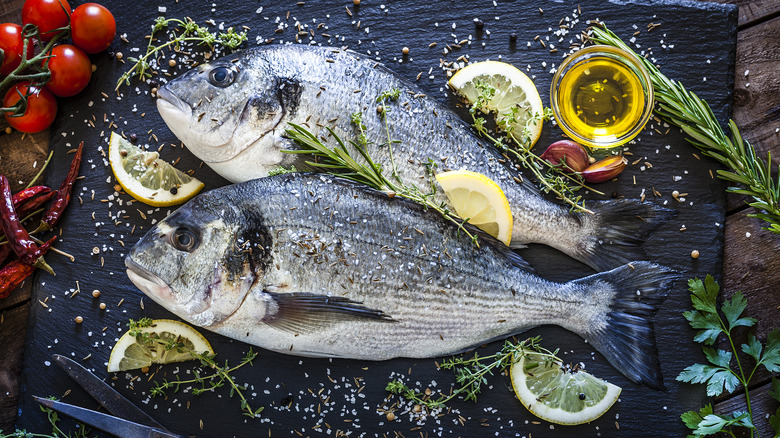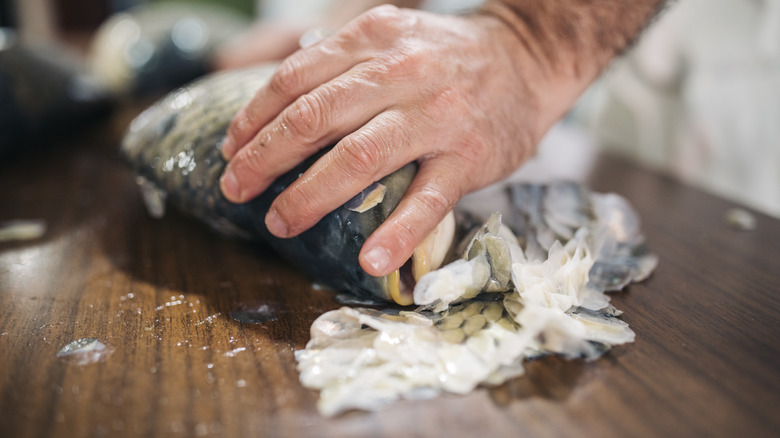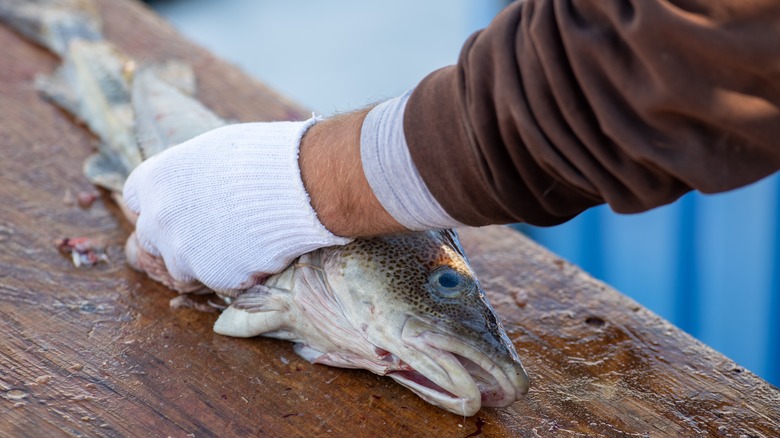The Back Of Your Knife Is The Only Tool Needed For Scaling A Fish
Buying a precut salmon or halibut filet is certainly a solid start to a great meal, but if you want to improve your favorite fish dish, you need to explore cooking a fish whole. Making a whole fish involves a bit more preparation, but it ultimately yields a deeper flavor and lets you enjoy even more delectable crispy fish skin.
Whether you're prepping a whole branzino from the fishmonger or a stringer full of perch that you caught yourself, you'll need to properly scale the fish before moving into the cooking phase. Slimy and potentially messy, the scaling process can be a bit intimidating and mysterious, especially the first time you give it a go. Luckily, you probably already own the only tool you need to properly scale a fish: a good chef's knife. Simply slide the back side of the knife over the scales to remove them from the skin, leaving behind a smooth surface perfect for cooking.
Keep the blade at an angle
Before you can use your knife to scale a fish, you'll need to complete two quick tasks. First, clean off the outer coating of slime that surrounds the bodies of most fish. This slime layer is important for fish health and completely normal on a fresh fish. This can be done by rinsing the fish meticulously. Then, use a pair of kitchen scissors or a sharp knife to remove all the fins still attached to the fish. These two steps will help you keep a firm grip on the fish and better navigate the contours of the body while scaling.
When the prep is complete, grab the tail with one hand and your knife in the other. Run the blunt back side of the knife over the fish's body, starting from the tail and working towards the head. Keep the knife blade at an angle so that it can get under the surface of the scales as it moves across the skin; the thick blunt edge will easily pry the scales loose. You may have to slide the knife repeatedly over some areas to remove stubborn scales. When you've thoroughly scaled one side, flip the fish over and repeat the process on the other side.
Other essential tips for scaling a fish
While the scaling process is fairly straightforward, there are a few tips and tricks that can make it easier. If you're having a difficult time keeping a firm grip on the tail, even after rinsing the outer slime layer, try wearing gloves during the scaling process. Rubber-coated gloves are especially useful for gripping slick fish.
After scaling, make sure to thoroughly rinse the body of the fish in cold water. Difficult scales will likely linger on the skin even after rigorous scaling and running water will help clean off any that remain. After the rinse, place the fish down on a clean surface away from where you completed the scaling and pat dry.
Finally, be prepared for a messy process. When scaling a fish, the edge of the knife will scatter hundreds of individual scales all over the cleaning area. These scales are very thin and sticky, making them difficult to remove from smooth kitchen surfaces, like countertops and sinks. Prep accordingly by laying down a layer of paper towels or newspaper to contain the debris. When you've finished, you can then simply throw the paper lining in the trash and be done with the mess.


